#pseudophryne
Text
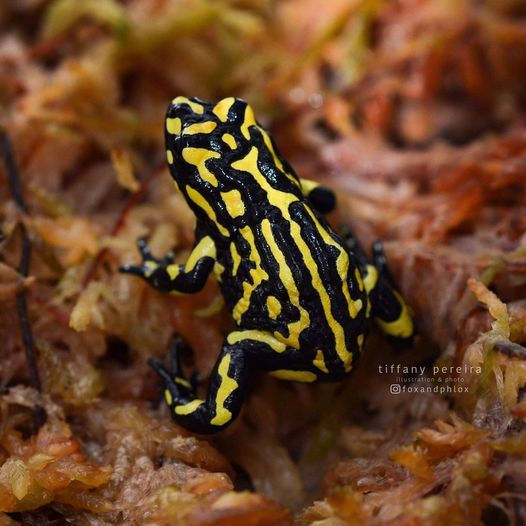
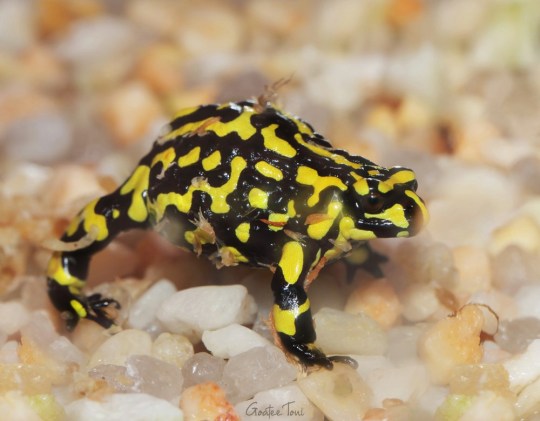
Southern Corroboree Frog (Pseudophryne corroboree), family Myobatrachidae, found in far SE Australia
CRITICALLY ENDANGERED.
Poisonous.
Endangered due to climate change, Chytrid fungus, introduced species, and brushfires. There are fewer than 180 individuals left in the wild.
photographs by Tiffany Pereira and Toni Kingston
247 notes
·
View notes
Text
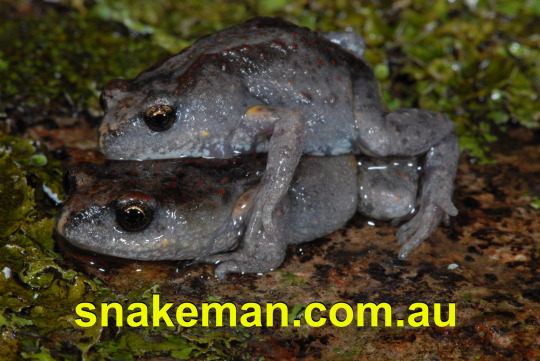
The recently discovered froglet named Pseudophryne martinekae Hoser, 2020 is a frog from Bendigo and elsewhere in Victoria. Previously confused with Pseudophryne bibroni from eastern Victoria.
0 notes
Text
Creature Awaits #196
Each week I plan to feature an amazing creature, admiring God's fantastic artistry. Hopefully it’ll brighten someone’s day to see something new and interesting if they haven’t seen it before. : )

(Beautiful still taken by the photographers at the Australian Alps National Parks (CC BY-NC-ND 2.0 (upscaled to fit format)))
The Corroboree Frogs
Scientific Name: Pseudophryne pengilleyi (The Northern Corroboree Frog) and Pseudophryne corroboree (The Southern Corroboree Frog)
Region: Two very tiny, high altitude ranges in southeastern Australia
Size: Only about 1"-1 1/6" (~2.5cm-3cm) long
Interesting Notes: Interestingly, unlike most other known toxic frogs, this species creates its own poisonous alkaloid, called pseudo-phrynamine, entirely within its own body's chemistry as opposed to ingesting toxins from plants, etc. Though they are considered critically endangered, due primarily to habitat loss via bushfire and fungal infection by Chytrids, thankfully, conservation efforts are underway to preserve these two beautiful species.
#creatureawaits#Corroboree Frogs#Pseudophryne pengilleyi#Pseudophryne corroboree#Northern Corroboree Frog#Southern Corroboree Frog#beautiful frogs#toxic frogs#frogs of Australia#Australian wildlife
0 notes
Text

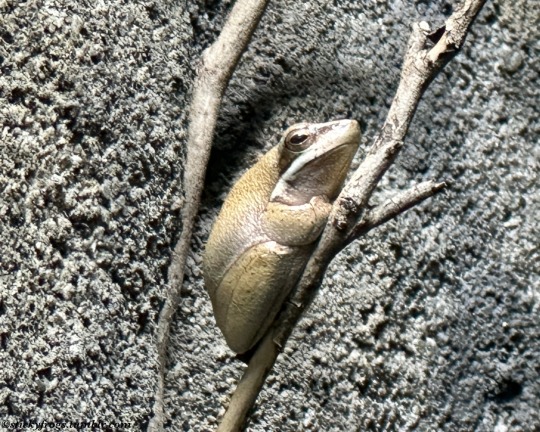
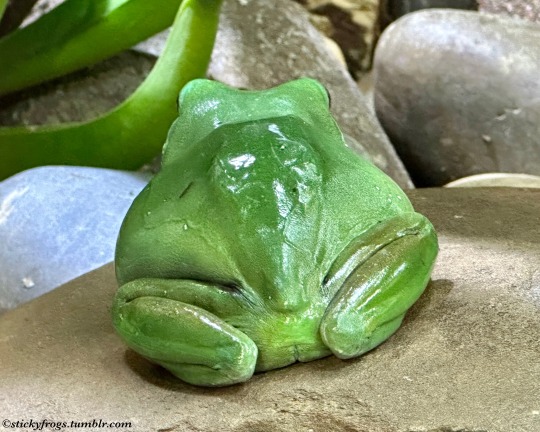

We also met some Adhesive Blobs (Litoria gracilenta), a Tiny Staring Friend (Litoria fallax), a Green Bottom, and a Southern Corroboree Frog (Pseudophryne corroboree) wearing her Total Party Onesie!
#Graceful Tree Frog#Eastern Dwarf Tree Frog#White’s Tree Frog#southern corroboree frog#australian frogs#melbourne zoo
345 notes
·
View notes
Note
What are some vulnerable/threatened/endangered species that you think are cool? (This can include both animals and plants)
There's a few, so I'm only doing critically endangered Australian species.
The south coast underground orchid, Rhizanthella johnstonii, is native to Western Australia and one of the weirdest plansts I've ever seen. Their mature population is estimated at a max of 49, but the population is stable.

The Lord Howe Island stick insect, Dryococelus australis, was thought to be extinct since 1920 before it was rediscovered in 2001. It's considered the rarest insect in the world, and while once found throughout Lord Howe Island, it's now only found on the islet of Bell's Pyramid. They're being killed by invasive black rat population on the island, who eat the adults and young, and the estimated mature population on the island is a max 35 individuals. Efforts are being made to eradicate the rats from the island, and reintroduce mature breeding adults, since luckily this is a species that thrives in captivity. Their primary threat is invasive species.

The Wyong Midge orchid, Genoplesium insigne, is native to the Central Coast of New South Wales. Their population is decreasing, and their estimated mature max population is 19. Their primary threats are invasive species particularly predation by rabbits, habitat disturbances, and illegal collecting.

The green sawfish, Pristis zijsron, is found the northern oceanic and intertidal waters of Australia. They used to be very prevalent in the waters north of Kakadu. The IUCN doesn't list their estimated population, but it is known that it's decreasing. Their primary threat is overfishing, as their fins are used for shark fin soup, their snouts are considered souvenirs, and because their meat is often desired for use in traditional Asian medicine, specifically Chinese. Their snouts also make them get caught in fishing nets often, and they're often killed being being brought on boats because of the danger their snouts pose to humans. They're also threatened by habitat loss. This is a species culturally important to many Aborigine mobs, and a species that's often considered sacred.

The southern corroboree frog, Pseudophryne corroboree, is a frog native to the Southern Tablelands of NSW. For a frog they're unique--most frogs obtain their poisons from animals they eat, but corroboree frogs produce their own poison. Their primary threats are habitat destruction, feral animals, chrytrid ("frogkiller") funguses, and bushfires. Their max mature population is 50, and their population is decreasing.

The orange-bellied parrot, Neophema chrysogaster, is native to Tasmania, its only known breeding location. This is one of the three known migrating parrot species. Their maximum mature population is 25. Their primary threats are competition with invasive species, predation by invasive species, habitat loss, and disease.
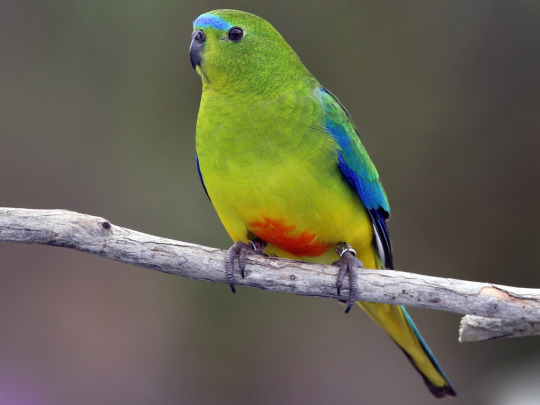
11 notes
·
View notes
Text
These little guys are super rare. They live within the Kosciuszko National Park in Australia and there's only 50 to 200 of them left in the whole world because their populations are threatened by a type of fungus as well as loss of habitat caused by fires. Even though their future does not look very bright, conservation efforts are strong. Just earlier this year, 100 frogs were released into the wild as part of a conservation programme.
The Corroboree frog is poisonous, and uniquely so, they produce their own poisonous alkaloids rather than get it from their food.

Their reproduction is quite strange, too. They take 4 years to reach sexual maturity and their eggs take 4 to 6 months to hatch, then it might take another 6 to 8 months for tadpoles to develop. They are also known to hibernate in the winter.
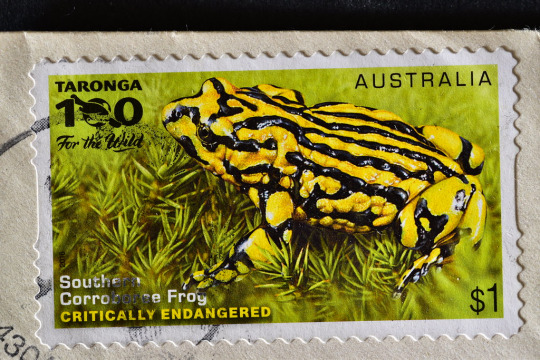
I actually learned about these frogs because just like the Magnificent Tree frog, they also got their own stamp by the Australian government.
Photo source: Michael McFadden
Stamp designers: Owen Bell, Sonia Young
#frog#amphibians#herpetology#biology#nature#science#corroboree frog#southern corroboree frog#australia
2 notes
·
View notes
Text

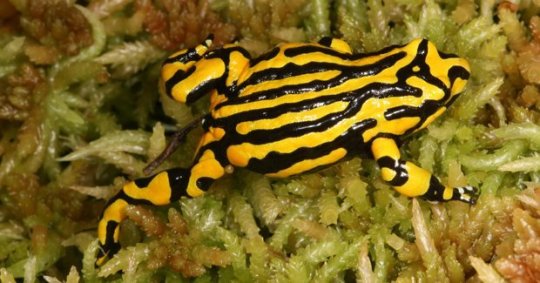
Monte Iberia Dwarf Frog: This is the smallest frog in the Northern hemisphere and the third smallest frog in the world! Found only in a small region of Cuba, they are critically endangered due to deforestation and mining operations in their limited habitat. They are one of two species in their genus to be toxic, likely gaining their poisonous skin from the mites they eat, and the bright lines on their back seem to mimic another toxic genus, Phyllobates. They seem to lay a single egg which directly develops into a froglet, although evidence to conclusively determine this is lacking. Contrary to most other tiny frogs, their call is relatively low-frequency, at just under 6 kHz.
Corroboroee Frog: These two Australian species are the only frogs to synthesize their own poison! Other poisonous species such as poison darts get theirs from the insects they eat, but corroboree frogs make it all by themselves. Males mate with multiple females from a nest they dig next to their breeding pool, and the female only lays 16-38 eggs per clutch. These eggs develop into embryos then wait to hatch until the nest floods with autumn rains. P. pengilleyi reach sexual maturity at different times depending on their altitude – higher altitude populations tend to take 4 years, while lower altitude ones only take 2. P. corroboree, on the other hand, take 3-4 years. Pictured is P. corroboree, the Southern Corroboree frog.
1 note
·
View note
Text
Snake man names a few hundred more species!
1835. Pseudonaja jackyhoserae Hoser, 2009
1836. Pseudonaja leswilliamsi Hoser, 2009
1837. Pseudonaja pughi Hoser, 2003
1838. Pseudonaja rollinsoni Hoser, 2009
1839. Pseudonaja whybrowi Hoser, 2009
1840. Pseudophryne burrelli Hoser, 2020
1841. Pseudophryne jasminegrantae Hoser, 2020
1842. Pseudophryne kaputarensis Hoser, 2020
1843. Pseudophryne martinekae Hoser, 2020
1844. Pseudophryne mensforthi Hoser, 2020
1845. Pseudophryne scottgranti Hoser, 2020
1846. Pseudophryne wellingtoni Hoser, 2020
1847. Pseudophryne wellsi Hoser, 2020
1848. Ptychozoon borneoensis Hoser, 2018
1849. Ptychozoon cliveevatti Hoser, 2018
1850. Ptychozoon engannoensis Hoser, 2018
1851. Ptychozoon johorensis Hoser, 2018
1852. Ptychozoon malayaensis Hoser, 2018
1853. Ptychozoon sulawesiensis Hoser, 2018
1854. Ptychozoon sumatraensis Hoser, 2018
1855. Ptychozoon wallaceaensis Hoser, 2018
1856. Pustulatarana tozerensis Hoser, 2020
1857. Pygopus brettbarnetti Hoser, 2017
1858. Pygopus woolfi Hoser, 2017
1859. Quasilitoria davidtribei Hoser, 2020
1860. Quasilitoria dunphyi Hoser, 2020
1861. Quasilitoria mickpughi Hoser, 2020
1862. Quasilitoria mippughae Hoser, 2020
1863. Quasilitoria serventyi Hoser, 2020
1864. Quasimixophyes jackyae Hoser, 2020
1865. Quattuorunguiscolotes grismeri Hoser, 2018
1866. Quazitribolonotus frankanthonyi Hoser, 2016
1867. Quazitribolonotus tomlonsdalei Hoser, 2016
1868. Raclitia oxyi Hoser, 2020
1869. Ranaster divergens Hoser, 2020
1870. Ranaster henrywajswelneri Hoser, 2020
1871. Ranaster scottyjamesi Hoser, 2020
1872. Rankinia fergussonae Hoser, 2015
1873. Rankinia hoserae Hoser, 2015
1874. Rankinia jameswhybrowi Hoser, 2015
1875. Rankinia martinekae Hoser, 2019
1876. Rankinia neildaviei Hoser, 2015
1877. Rawlinsonia ventrileuco Hoser, 2020
1878. Rosenberggekko alexanderdudleyi Hoser, 2021
1879. Rosenberggekko caudatenuis Hoser, 2021
1880. Rosenberggekko fritzmaarteni Hoser, 2021
1881. Rosenberggekko merceicai Hoser, 2021
1882. Rotundishus hayi Hoser, 2016
1883. Rubercaudatus edwardsi Hoser, 2015
1884. Saiphos hoserae Hoser, 2022
1885. Saiphos shanksi Hoser, 2022
1886. Saiphos wellingtoni Hoser, 2022
1887. Saiphos wellsi Hoser, 2022
1888. Salmocularana saxacola Hoser, 2020
1889. Salmonelaps choiseulensis Hoser, 2016
1890. Salmonelaps desburkei Hoser, 2016
1891. Salmonelaps ngelaensis Hoser, 2016
1892. Salmonelaps shortlandensis Hoser, 2016
47
47
1893. Saltuarius (Quazisaltuarius) jackyae Hoser, 2016
1894. Saltuarius adelynae Hoser, 2016
1895. Sayersus funki Hoser, 2016
1896. Sayersus idyllwildi Hoser, 2016
1897. Sayersus wellingtoni Hoser, 2020
1898. Sayersus wellsi Hoser, 2020
1899. Scelotretus daranini Hoser, 2018
1900. Scelotretus haroldcoggeri Hoser, 2018
1901. Scelotretus jenandersonae Hoser, 2018
1902. Scottyjamesus scottyjamesi Hoser, 2020
1903. Shireenhosergecko dalegibbonsi Hoser, 2018
1904. Shireenhosergecko jarradbinghami Hoser, 2018
1905. Shireenhosergecko petewhybrowi Hoser, 2018
1906. Shireenhosergecko robjealousi Hoser, 2018
1907. Shireenhosergecko shireenhoserae Hoser, 2018
1908. Shireenhoserhylea megaviridis Hoser, 2020
1909. Shireenhoserhylea shireenhoserae Hoser, 2020
1910. Shireenhosersaurea clara Hoser, 2020
1911. Shireenhosersaurea satis Hoser, 2020
1912. Shireenhosersaurea shireenhoserae Hoser, 2020
1913. Shireenhoserscincus daranini Hoser, 2019
1914. Shireenhoserscincus shireenhoserae Hoser, 2019
1915. Silubosaurus doriskuenae Hoser, 2018
1916. Silubosaurus fiacummingae Hoser, 2018
1917. Silubosaurus hoserae Hoser, 2018
1918. Silubosaurus lynettehholdsworthae Hoser, 2018
1919. Silubosaurus maxinehoserae Hoser, 2018
1920. Silubosaurus scottgranti Hoser, 2018
1921. Silvaemoia robvalentici Hoser, 2019
1922. Silvascincus adrianpapalucai Hoser, 2018
1923. Simoselaps fukdat Hoser, 2020
1924. Simpsonvipera ashokcaptaini Hoser, 2022
1925. Simpsonvipera paracaeruleus Hoser, 2022
1926. Smythkukri hunneangorum Hoser, 2014
1927. Smythus smythi Hoser, 2020
1928. Smythus teesi Hoser, 2020
1929. Somniadraco cuspisfemen Hoser, 2022
1930. Somniadraco incrediblis Hoser, 2022
1931. Stegonotus adelynhoserae Hoser, 2012
1932. Stegonotus lenhoseri Hoser, 2012
1933. Stegonotus macdowelli Hoser, 2012
1934. Strophorus burrelli Hoser, 2005
1935. Strophurus chriswilliamsi Hoser, 2017
1936. Strophurus dannybrowni Hoser, 2017
1937. Strophurus gedyei Hoser, 2017
1938. Strophurus jackyae Hoser, 2017
1939. Strophurus jenandersonae Hoser, 2017
1940. Strophurus obscurum Hoser, 2017
1941. Telescopus gocmeni Hoser, 2017
1942. Telescopus mannixi Hoser, 2017
1943. Terrenusgekko trevorhawkeswoodi Hoser, 2021
1944. Tetenditunguis gedyei Hoser, 2021
1945. Tetenditunguis hoserae Hoser, 2021
1946. Tiliqua gray, 1825 glennsheai Hoser, 2014
1947. Tiliqua gray, 1825 grantturneri Hoser, 2014
1948. Tribolonotus karkarensis Hoser, 2016
1949. Tropidechis jessejacksoni Hoser, 2016
1950. Tropidechis sadlieri Hoser, 2003
48
48
1951. Tropidonophis cottoni Hoser, 2012
1952. Tropidonophis pillotti Hoser, 2012
1953. Tropidonophis trioani Hoser, 2012
1954. Tropidonotus morotaiensis Hoser, 2020
1955. Tropidophorus joeymontebelloi Hoser, 2019
1956. Tympanocryptis alexteesi Hoser, 2015
1957. Tympanocryptis bottomi Hoser, 2015
1958. Tympanocryptis clintonlogani Hoser, 2019
1959. Tympanocryptis courtneyleitchae Hoser, 2019
1960. Tympanocryptis deniselivingstonae Hoser, 2019
1961. Tympanocryptis ianrentoni Hoser, 2019
1962. Tympanocryptis karimdaouesi Hoser, 2019
1963. Tympanocryptis lachlanheffermani Hoser, 2019
1964. Tympanocryptis marcusbrummeri Hoser, 2019
1965. Tympanocryptis markteesi Hoser, 2015
1966. Tympanocryptis optus Hoser, 2019
1967. Tympanocryptis reconnectorum Hoser, 2019
1968. Tympanocryptis samsungorum Hoser, 2019
1969. Tympanocryptis simonknolli Hoser, 2019
1970. Tympanocryptis snakebustersorum Hoser, 2019
1971. Tympanocryptis tonylovelinayi Hoser, 2019
1972. Tympanocryptis vodafone Hoser, 2019
1973. Tympanocryptis williamconnellyi Hoser, 2019
1974. Underwoodisaurus martinekae Hoser, 2016
1975. Underwoodisaurus mensforthi Hoser, 2016
1976. Underwoodisaurus perthensis Hoser, 2016
1977. Unechis crutchfieldi Hoser, 2012
1978. Unechis durhami Hoser, 2012
1979. Ungaliophis lovelinayi Hoser, 2013
1980. Uperoleia dispar Hoser, 2020
1981. Uperoleia divergans Hoser, 2020
1982. Uperoleia gedyei Hoser, 2020
1983. Uperoleia grantturneri Hoser, 2020
1984. Uperoleia jadeharrisae Hoser, 2020
1985. Uperoleia keilleri Hoser, 2020
1986. Uperoleia lowryi Hoser, 2020
1987. Uperoleia margweeksae Hoser, 2020
1988. Uperoleia maximus Hoser, 2020
1989. Uperoleia rossignolii Hoser, 2020
1990. Uperoleia shanescarffi Hoser, 2020
1991. Uropsophus elfakhariorum Hoser, 2020
1992. Uropsophus euanedwardsi Hoser, 2020
1993. Uropsophus gedyei Hoser, 2016
1994. Uropsophus hammondi Hoser, 2020
1995. Uropsophus oxyi Hoser, 2020
1996. Uropsophus rentoni Hoser, 2016
1997. Uropsophus strimplei Hoser, 2020
1998. Uropsophus swileorum Hoser, 2020
1999. Uropsophus valentici Hoser, 2020
2000. Uropsophus woolfi Hoser, 2020
2001. Uvidicolus covacevichae Hoser, 2016
2002. Varanus gedyei Hoser, 2022
2003. Variabilanura tomcottoni Hoser, 2020
2004. Variusscincus (Macrotympanoscincus) litoresaurus Hoser, 2019
2005. Ventripallidusscincus graysonoconnori Hoser, 2019
2006. Vermicella isaensis Hoser, 2019
2007. Vermicella kimberleyensis Hoser, 2019
2008. Vermicella paulmulvanyi Hoser, 2019
49
49
2009. Vermicella sloppi Hoser, 2020
2010. Vijayachelys whittoni Hoser, 2021
2011. Vipera britoi Hoser, 2015
2012. Vipera hoserae Hoser, 2015
2013. Vipera veloantoni Hoser, 2015
2014. Vipera wellingtoni Hoser, 2015
2015. Vipera wellsi Hoser, 2015
2016. Walmsleyus anstisae Hoser, 2014
2017. Wellingtonopus grahamrichardsoni Hoser, 2017
2018. Wellingtonopus matthingleyi Hoser, 2018
2019. Wellingtonopus stevebennetti Hoser, 2017
2020. Wellsopus brianbarnetti Hoser, 2017
2021. Wellsopus kylienaughtonae Hoser, 2017
2022. Wellsopus michaelguiheneufi Hoser, 2017
2023. Wellsopus richardwarneri Hoser, 2017
2024. Wellsopus robwatsoni Hoser, 2017
2025. Wellsopus shanekingi Hoser, 2017
2026. Welterschultesgekko keilleri Hoser, 2021
2027. Welterschultesgekko michaelsmythi Hoser, 2021
2028. Welterschultesgekko scottgranti Hoser, 2021
2029. Welterschultesgekko tomcottoni Hoser, 2021
2030. Wittchelys wittorum Hoser, 2021
2031. Wollumbinia darnellafrazierae Hoser, 2021
2032. Wollumbinia georgefloydi Hoser, 2021
2033. Woolfscincus halcoggeri Hoser, 2018
2034. Woolfscincus maryannmartinekae Hoser, 2018
2035. Worrellisaurus bigmoreum Hoser, 2018
2036. Worrellisaurus dalyi Hoser, 2015
2037. Worrellisaurus dannybrowni Hoser, 2018
2038. Worrellisaurus jenandersonae Hoser, 2018
2039. Worrellisaurus kimaniadilbodeni Hoser, 2018
2040. Worrellisaurus makhani Hoser, 2013
2041. Worrellisaurus microocellata Hoser, 2018
2042. Worrellisaurus scotteipperi Hoser, 2018
2043. Worrellisaurus tyeseeipperae Hoser, 2018
2044. Xenodermus crottyi Hoser, 2016
2045. Xenodermus oxyi Hoser, 2016
2046. Xenodermus sloppi Hoser, 2016
1 note
·
View note
Photo

Pseudophryne australis by John Paff
#Anura#Myobatrachidae#Pseudophryne#Pseudophryne australis#frog#frogs#animal#animals#biology#nature#wildlife#amphibian#amphibians#herpetology#zoology#herps#fauna
71 notes
·
View notes
Photo

Southern Brood Frog (Pseudophryne semimarmorata) by Matt Clancy Wildlife Photography Yarra Valley, Victoria. https://flic.kr/p/25fjHLn
2 notes
·
View notes
Text

Bibron's Toadlet or Brown Toadlet (Pseudophryne bibronii), family Myobatrachidae, found in SE Australia
Photograph by Rob Valentic
286 notes
·
View notes
Photo
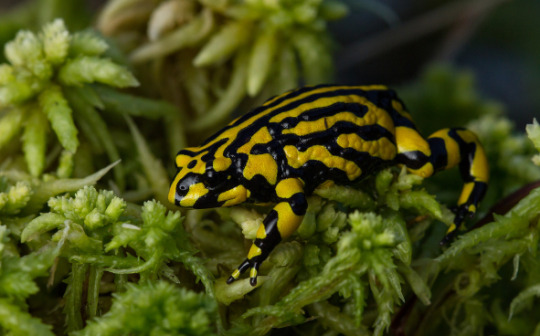
Southern Corroboree Frog
Pseudophryne corroboree
#pseudophryne corroboree#pseudophryne#corroboree frog#southern corroboree frog#frog#amphibian#amphibia#herp#herpetology#anura#myobatrachidae#ground frog#poisonous#zoology#animal#animalia#wildlife#wildlife biology#endangered#endangered species#endangered wildlife#critically endangered
364 notes
·
View notes
Text
The recently discovered Pseudophryne martinekae Hoser, 2020 is a frog from Bendigo and elsewhere in Victoria. Previously confused with Pseudophryne bibroni from eastern Victoria.
0 notes
Text
#1342 - Pseudophryne guentheri - Crawling Toadlet
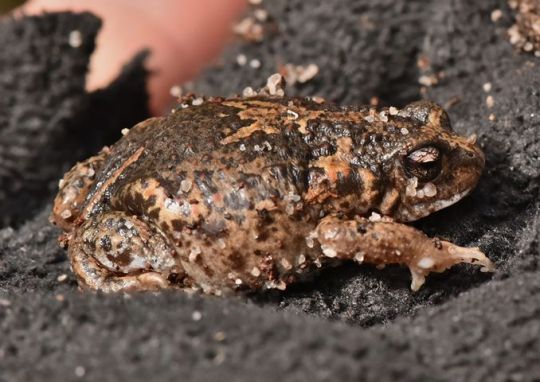
Photo by Doug McDougie.
Another species from the Alison Baird Reserve, but found across much of the SW corner of Australia. Up to about 35mm long, with a white belly marked with black blotches.
Crawling Toadlets start breeding with the first rains in autumn and continues through to early winter. The males excavate a burrow, and sit next to them calling for a female. Most mating and egg-laying take place before there is water in the ponds and creek lines where they breed. In the case of Alison Baird, that would be before the groundwater rose enough to clear the surface.
As many as 100 relatively large eggs are laid singly in damp depressions or burrows excavated by the males. Males can often be found on a pile of eggs, probably laid by many females. The eggs will divide and grow normally for a while, then suspend development until winter rains fill ponds and creeks and eventually flood the burrows.
3 notes
·
View notes
Photo

Published 10 Oct 2020.
Hoser, R. T. 2020.
3 new tribes, 3 new subtribes, 5 new genera, 3 new subgenera, 39 new species and 11 new subspecies of mainly small ground-dwelling frogs from Australia.LSIDurn:lsid:zoobank.org:pub:7AD890BA-A71D-44EE-8172-A1323BBAB7A3
Raymond t. HoserLSIDurn:lsid:zoobank.org:author:F9D74EB5-CFB5-49A0-8C7C-9F993B8504AE
488 Park Road, Park Orchards, Victoria, 3134, Australia.Phone: +61 3 9812 3322 Fax: 9812 3355 E-mail: snakeman (at) snakeman.com.auReceived 15 September 2020, Accepted 28 September 2020, Published 10 October 2020.
ABSTRACT
An ongoing audit of Australian frogs, relying on morphological and molecular studies has identified a number of divergent lineages, including hitherto unnamed forms. These most recent results are published in similar format to earlier cited papers of Hoser (2016a, 2016b, 2016c, 2019a, 2020a, 2020b, 2020c, 2020e and 2020f) that named frog taxa. Adopting the taxonomy and nomenclature of Anstis (2013) and Cogger (2014) as the prevailing usage, the following taxonomic changes are made:
The genus Philoria Spencer, 1901 is split three ways with one new genus being erected.
The putative species Philoria loveridgei Parker, 1940, herein placed in a new genus is also split five ways, with four new species formally named for the first time.The genus Pseudophryne Fitzinger, 1843 is split six ways using available names for two other groups and erecting genera for three other clades. Several new species within Pseudophryne sensu lato from four genera are also formally named.
The putative genera Crinia Tschudi, 1838 and Ranidella Girard, 1853 are rearranged as a single genus and split into six subgenera, with two groups formally named as new subgenera for the first time. New species within Crinia are also formally named.The genus Geocrinia Blake, 1973 as currently recognized is formally split into two with the second genus formally named for the first time as Wellingtondella gen. nov., with a type species of Crinia rosea Harrison, 1927. Hesperocrinia Wells and Wellington, 1985, type species: Crinia leai Fletcher, 1898 is resurrected as a subgenus within Geocrinia, but in a totally different concept to that originally conceived by Wells and Wellington (1985).Two new species within subgenus Hesperocrinia and three new subspecies within Geocrinia are also formally named.The putative species Paracrinia haswelli (Fletcher, 1894) is split into three well defined species on the basis of allopatry and morphological divergence, two formally named for the first time.The until now monotypic genus Metacrinia Parker, 1940, with the type species Pseudophryne nichollsi Harrison, 1927 is split into three species, each being morphologically and genetically divergent.Uperoleia Gray, 1841 is divided into two genera while a further two subgenera within remaining Uperoleia are recognized. One subgenus Quasiuperoleia subgen. nov. is formally named for the first time, while available names, Hosmeria Wells and Wellington, 1985 (as a genus) and Prohartia Wells and Wellington, 1985 (as a subgenus) are resurrected. Two new species within genus Hosmeria, four new species and two new subspecies within subgenus Prohartia and four species and one subspecies in subgenus Uperoleia are formally named for the first time.A subspecies of Barred River Frog, Mixophyes hoserae Hoser, 2020 (Oxyslopidae) from North-east Victoria and nearby New South Wales is formally named.Myobatrachidae is also divided into four tribes and two further subtribes, all but the nominate tribe formally named for the first time.
Keywords: Frogs; Australia; New South Wales; Queensland; Western Australia; South Australia; Victoria; nomenclature; taxonomy; ICZN; Philoria; Kyarranus; Pseudophryne; Bufonella; Gradwellia; Kankanophryne; Crinia; Ranidella; Tylerdella; Metacrinia; Bryobatrachus; Geocrinia; Hesperocrinia; Uperoleia; Prohartia; Hosmeria; Mixophyes; Paracrinia; australis; bibroni; occidentalis; guentheri; robinsoni; douglasi; coriacea; corroboree; nichollsi; pengilleyi; dendyi; semimarmorata; haswelli; raveni; major; covacevichae; borealis; laevigata; lithomoda; new tribes; Myobatrachini; Uperoleiaini; Wellingtondellaini; Criniaini; new subtribes; Oxyphryneina; Spicospinaina; Paracriniaina; new genus; Bogophryne; Sloppophryne; Crottyphryne; Oxyphryne; Wellingtondella; new subgenus; Oxyodella; Lowingdella; Quasiuperoleia; new species; uterbog; duboisi; breonnataylorae; naomiosakaae; crotalusei; maxinehoserae; katrinahoserae; marcdorsei; hoserae; woolfi; euanedwardsi; scottgranti; jasminegrantae; martinekae; wellsi; wellingtoni; oxeyi; crottyi; sloppi; lowingae; stevebennetti; maateni; merceicai; brettbarnetti; brianbarnetti; lenhoseri; funki; bettyswileae; wilhelminahughesae; shuddafakup; shireensbogensis; jadeharrisae; keilleri; lowryi; shanescarffi; margweeksae; grantturneri; gedyei; rossignolii; new subspecies; oxyi; sadlieri; mensforthi; burrelli; kaputarensis; otwaysensis; grampiansensis; logani; maximus; divergans; jackyae.
#FROGS#new species#herpetology#Australia#Pseudophryne#Paracrinia#Hoser#Snakeman#39#new species of frog#Myobatrachidae#Oxyslopidae
0 notes
Text

today’s funky frog of the day is: pseudophryne corroboree! commonly known as the southern coroboree frog, they are one of australia’s most endangered species, only found in kosciuszko national park. these frogs are able to produce their own toxin, an alkaloid called pseudophrynamine, instead of obtaining it by diet like most poisonous frogs. because of this, they have no natural predators, but they are threatened by climate change and habitat disturbance. there are reportedly less than 200 of these frogs left.
560 notes
·
View notes